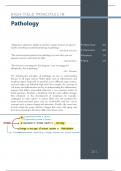HIGH-YIELD PRINCIPLES IN
Pathology
“Digressions, objections, delight in mockery, carefree mistrust are signs of ` Cellular Injury 202
health; everything unconditional belongs in pathology.”
—Friedrich Nietzsche ` Inflammation 209
“You cannot separate passion from pathology any more than you can ` Neoplasia 215
separate a person’s spirit from his body.”
—Richard Selzer ` Aging 225
“My business is not prognosis, but diagnosis. I am not engaged in
therapeutics, but in pathology.”
—H.L. Mencken
The fundamental principles of pathology are key to understanding
diseases in all organ systems. Major topics such as inflammation and
neoplasia appear frequently in questions across different organ systems,
and such topics are definitely high yield. For example, the concepts of
cell injury and inflammation are key to understanding the inflammatory
response that follows myocardial infarction, a very common subject of
board questions. Similarly, a familiarity with the early cellular changes
that culminate in the development of neoplasias—for example,
esophageal or colon cancer—is critical. Make sure you recognize the
major tumor-associated genes and are comfortable with key cancer
concepts such as tumor staging and metastasis. Finally, take some time
to learn about the major systemic changes that come with aging, and
how these physiologic alterations differ from disease states.
201
FAS1_2024_04-Pathol.indd 201 1/29/24 4:36
, 202 SEC TION II Pathology PATHOLOGY—Cellular Injury
` PATHOLOGY—CELLULAR INJURY
Cellular adaptations Reversible changes that can be physiologic (eg, uterine enlargement during pregnancy) or pathologic
(eg, myocardial hypertrophy 2° to systemic HTN). If stress is excessive or persistent, adaptations
can progress to cell injury (eg, significant LV hypertrophy myocardial injury HF).
Hypertrophy structural proteins and organelles in size of cells. Example: cardiac hypertrophy.
Hyperplasia Controlled proliferation of stem cells and differentiated cells in number of cells (eg, benign
prostatic hyperplasia). Excessive stimulation pathologic hyperplasia (eg, endometrial
hyperplasia), which may progress to dysplasia and cancer.
Atrophy in tissue mass due to in size ( cytoskeleton degradation via ubiquitin-proteasome pathway
and autophagy; protein synthesis) and/or number of cells (apoptosis). Causes include disuse,
denervation, loss of blood supply, loss of hormonal stimulation, poor nutrition.
Metaplasia Reprogramming of stem cells replacement of one cell type by another that can adapt to a new
stressor. Usually due to exposure to an irritant, such as gastric acid ( esophageal epithelium
replaced by intestinal epithelium, called Barrett esophagus) or tobacco smoke ( respiratory
ciliated columnar epithelium replaced by stratified squamous epithelium). May progress to
dysplasia malignant transformation with persistent insult (eg, Barrett esophagus esophageal
adenocarcinoma). Metaplasia of connective tissue can also occur (eg, myositis ossificans, the
formation of bone within muscle after trauma).
Dysplasia Disordered, precancerous epithelial cell growth; not considered a true adaptive response.
Characterized by loss of uniformity of cell size and shape (pleomorphism); loss of tissue
orientation; nuclear changes (eg, nuclear:cytoplasmic ratio and clumped chromatin). Mild and
moderate dysplasias (ie, do not involve entire thickness of epithelium) may regress with alleviation
of inciting cause. Severe dysplasia often becomes irreversible and progresses to carcinoma in situ.
Usually preceded by persistent metaplasia or pathologic hyperplasia.
Inability
to adapt Irreversible
injury necrosis
Hyperplasia Hypertrophy Atrophy or apoptosis
Change in cell size
and/or number
Severe stress
or injury
Normal cells
Change in Change in Change in cell type
cell structure cell type and structure
Dysplasia Metaplasia Neoplasia
Irreversible
Reversible
If chronic irritant persists
FAS1_2024_04-Pathol.indd 202 1/29/24 4:37
, Notes Date / /
Pathology




